Author: Amanda Lillie
3. Apertures and arches, porches and loggias
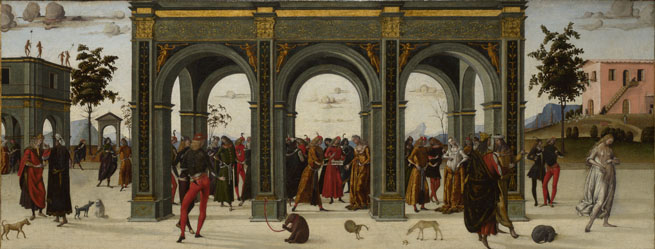
It is astonishing how ubiquitous and prominent arches and openings, doorways, windows, loggias and porches are in Italian Renaissance paintings. Apart from the three-dimensional frames with which almost all paintings on panel or canvas were furnished in this period, within the picture the main figures were usually reframed, bounded, and demarcated by fictive architecture (fig. 9). Renaissance artists explored every type of arch and entrance from city gates to narrow half-open doorways within houses.
The fundamental purpose of arches to frame entry points to towns and cities, zones within cities, buildings and parts of buildings, meant that they were designed to make a strong impression on people arriving and entering through them. Arches mark key thresholds, physically and metaphorically separating inside from outside, open from closed, public from private, secular from sacred, or different degrees of any of these states (such as the more holy space around the Virgin and Child from the slightly less holy space around the attendant saints). Since arrival and departure are connected with ritual in almost every society in every period, the architectural markers that create these thresholds bear all the significance associated with those rituals. The design of the arch, gateway, door, porch, loggia, or portico is charged with meanings and associations, whether ceremonial, sacred, political or personal.
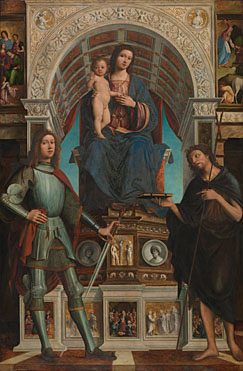
The elaborate arch surrounding Lorenzo Costa and Gianfrancesco Maineri's 'Virgin and Child with Saints' (fig. 10) partly acts as a tabernacle exalting the sacred figures, and at the same time suggests that this is an illusionistic chapel with frescoed walls continuing either side of the arch. Its coffered vault and marble pilasters with capitals that fuse with the entablature frieze continuing inside the arch are both features reminiscent of Roman triumphal arches. The triumphant note conveyed by the architecture is further enhanced by the perspectival construction ensuring that the worshippers look steeply up towards the saints from a position of lowly humility. These military associations provide a suitable framework for the soldier saint on the left, but they coexist with the powerful metaphor of the Virgin as ‘porta coeli’ – an arch or gateway to heaven, perhaps suggested by the blue sky behind.
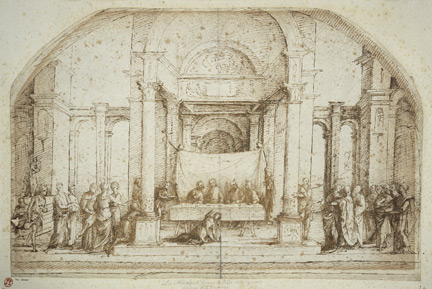
In Lorenzo Costa's drawing ‘Christ in the House of Simon the Pharisee’ (fig. 11) a similar architectural strategy is employed to separate, frame and honour the central narrative, with Christ seated at the table and Mary Magdalene on the floor below him. Costa took the basic structure of an arched illusionistic chapel used for many altarpieces and extended it for the wider format of a frescoed wall by adding tall buildings at either side with a linking screen of arches behind. The resulting architectural and spatial effects are quite different from those in the Costa-Maineri altarpiece, which is confrontational in its steep viewpoint, in the looming proximity of its figures and grand architectural structures, and in its almost overwhelming decorative detail. By contrast, in the drawing the figures are small in relation to the soaring arches. They are set back from the picture plane at a distance from the viewer, stretched across a series of wide steps, and surrounded by expanses of air, demonstrating how a feature such as the arched chapel structure can be transformed into something more open and spreading, part of a civic or palatial complex, with narrative rather than purely iconic potential.
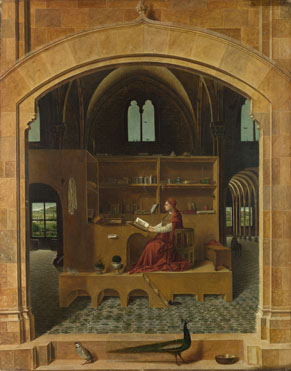
An entirely different solution for an arch is created by Antonello da Messina for his ‘Saint Jerome in his Study’ (fig. 12). The entrance arch to the painting declares itself to be a massive structure with considerable depth, articulated through the artificially stratified blocks of stone (figs. 13 and 14). The ledge itself has a step in it; the birds and bowl are placed on the lower ledge, but we need to rise over the upper ledge in order to enter the painting. Whereas this construction of a high sill acts as a quasi-vertical barrier, the inward layering of the arch and its base focus in telescopically to facilitate entrance into Jerome’s interior zone.
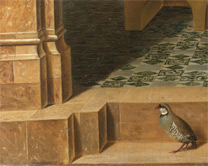
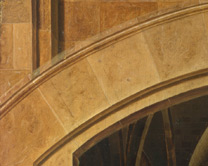
The effect of the arch seems contradictory, sending out a message of exclusion by separating what is outside – the sandstone blocks, the diffused light, the birds and the brass bowl – from the saint, and at the same time providing a means of getting inside. The invitation into the space is also an invitation to act as the saint does – to study.
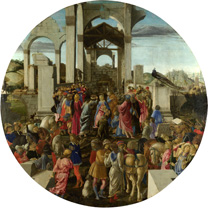
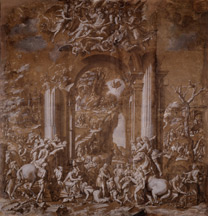
In the ‘Adorations of the Kings’ by Botticelli and Peruzzi (figs. 15 and 16) the triumphal arches are set further back, in the middle ground, so that they become arches in the landscape. Since these arches are no longer on the threshold of the picture, as spectators we do not enter through them, but visually move in their direction. In the case of Peruzzi’s ‘Adoration’ the focal power of the arch is fully exploited, drawing the spectator in towards the Virgin and Child positioned at the very base of the left-hand column, and towards the Annunciation to the Shepherds taking place on the rocky cliffs on the other side of the arch. Yet the main characters – the Virgin and Child and the Kings – are dwarfed by the central architectural structure, and the multiplicity of figures and exotic animals with many sub-plots and intricate details of landscape and architecture distract from the main story. In the end the ruined triumphal arch is the message here, representing the passing of the old order while declaring itself to be the portal to Christianity. It is established as a free-standing, centrally placed monument, the figures conceived in relation to the arch, as many of them physically interact with it.
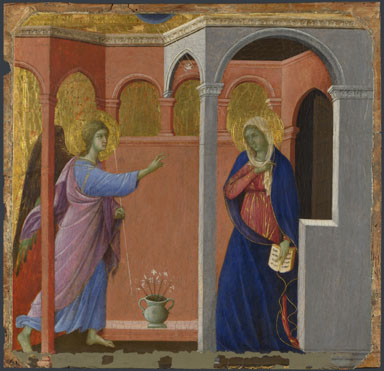
Multiple arched structures could incorporate the honorific functions
of the triumphal arch or aedicule while expanding to include more figures, and to create complex narratives.
The porches housing the Virgin in the Annunciation scenes by Duccio and the Master of the Judgment of Paris
(figs. 17 and 18) pragmatically and ingeniously combine several functions in one structure. They are in one sense baldacchins, or honorific canopies, but instead of being placed over a high altar or being carried through the streets to shade the head of a great dignitary, here they honour the Virgin within a painting.
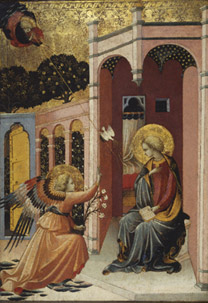
In another sense they have a plausible narrative function and practical use as a shelter for the entrance to the Virgin’s house. The arched entrances also serve a key symbolic role to signify Christ’s incarnation as a gateway to salvation. The diagonal placing of these porches with their prominent jutting corners and oblique angles may derive from the need to demonstrate their depth and three-dimensional structure, which would not be so evident if the porches were parallel or perpendicular to the picture plane.10 Their thrust towards the spectator creates more physical presence and could therefore be seen as an attention-seeking ploy by the artists. Ghiberti had adopted the same idea for both his ‘Annunciation’ and ‘Adoration of the Magi’ on the north door of the Florence Baptistery.
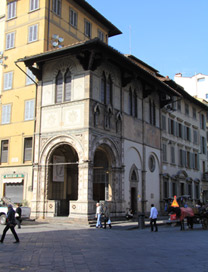
Open loggias at the corners of buildings would have been familiar to a 15th-century audience, at least in Florence, where they were adopted by the Bigallo confraternity on the Piazza del Duomo (1352–8) or in the Medici family palace (about 1445–9, fig. 19).
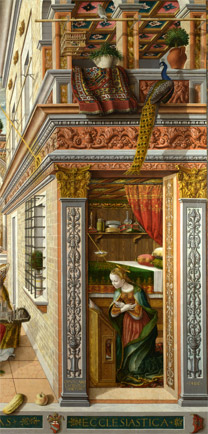
The open corners of palaces adopted by Zanobi Strozzi and Carlo Crivellli (fig. 20) may at first sight look like these existing corner loggias. However, both Strozzi and Crivelli closed off the other side of the corner and created proper entry points there – the doorway through which Helen is abducted in Strozzi’s panel and the large window protected by a grille in Crivelli’s altarpiece. The logic of practical construction applied to the rest of each building seems to have been abandoned in this one area to enable visual access through an opening in the front wall.
Significantly, instead of allowing the ‘unreal’ or implausible front openings to be mere apertures that do not draw attention to themselves, they have been meticulously designed with emphatic Corinthian pilasters applied with architectural ingenuity, fine steps or lintels, and low-relief sculpture along the inner jamb in the case of Crivelli. The corner itself is made important. In both these cases the jutting corners with their gratuitous openings are designed rhetorically to open up their interior meanings for the viewer.
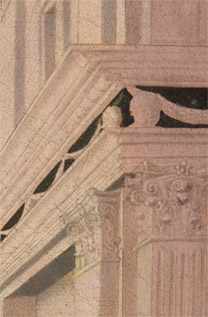
Emphatic foreground corners in pictures may partly relate to the celebration of the ‘canto’ or street corner as a site of social ritual and interaction in 15th-century Florence, if not throughout Italy. Such locations were the most valuable palace sites when it came to real estate acquisition. Paintings featuring them, which offered artists a chance for technical display, probably derive from perspectival exercises showing the front and side of a building simultaneously.11 They may also reflect architects’ concern with corner solutions as a test of design skills, in which case they may be a sort of ‘paragone’ – a competitive demonstration of the painter’s ability to do what architects did and improve on it. While Crivelli’s gilded bronze capitals and ostentatious entablature show a greater concern with materials and inventive forms, Zanobi Strozzi’s corner (fig. 21) reveals a greater interest in structural logic adapted from Brunelleschi’s architecture. The use of the thin pilaster fillet complete with its own (tiny section of) base between the two corner pilasters is conceptually similar to pilaster fillets used by Brunelleschi in the Barbadori Chapel (1419–23), the Old Sacristy at San Lorenzo (1418–29), and the Pazzi Chapel (1424–61), as well as the layered corner solutions for the giant order of pilasters in the San Lorenzo crossing (from 1421, fig. 22) and at the Palazzo di Parte Guelfa (begun about 1420).
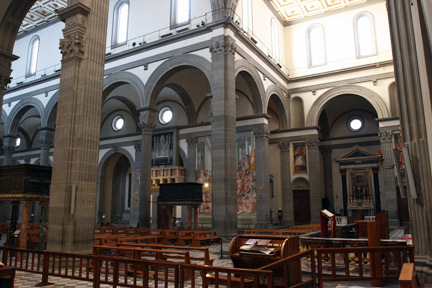
Zanobi Strozzi uses the pilaster fillet to show the continuation of the solid structure of the outer wall under the main pilasters, and to define the very point of the corner.12 It is part of his predilection for a layered façade that reveals different levels of projection and recession, culminating in the jutting corner.
The main purpose of these openings, however, was to reveal and frame the subject. Crivelli creates a picture within the picture, framing the Virgin in the opening of her house. This is achieved at the expense of any communication between Gabriel and the Virgin. Zanobi Strozzi uses the open corner quite differently to construct the plot, creating movement and a sense of urgency, since Helen of Troy has already been carried out of the house on the shoulders of a young man, her robes still trailing over its steps. Here the inner room is used to display the statue of a god (possibly a goddess),13 and a series of other women at different stages in the abduction process.
This is serial abduction with five taking place simultaneously: two women are already out of doors, one only partly visible in the doorway itself, another is being grabbed inside, while a further young man is about to select one from a group of four women in front of the statue. Each kidnap is displayed in a different relation to the building. It is the building that establishes a time frame or sequence of actions. The topic of abduction can best be conveyed by removal from a place, by enforced departure, firstly from a protected interior, then away from the island across the sea to another place. The building in this picture, whether it is a palace, or a temple in the form of a palace, represents the interior safety from which abductions take place.
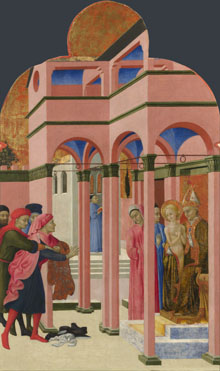
In Sassetta’s ‘Saint Francis renounces his Earthly Father’ (fig. 23) a building takes up most of the panel. Its apparently cruciform plan, multiple piers and central oculus at the upper level suggest this is a church or monastery, its open arches framing the Bishop and Saint Francis to the right. While no-one occupies the centre ground, Francis’s father significantly remains outside the shelter of the church to the left, physically restrained from crossing its threshold (fig. 24). But his desperation to reclaim his son is expressed in his rigid, outstretched arm reaching across an archway towards him, and in the angry profile of his staring eye, open mouth and jutting chin, a sliver of which projects beyond the end wall of the church.
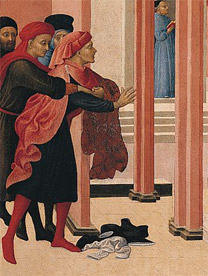
Sassetta’s use of the left-hand arch is most precisely planned since it lies on the threshold of secular space. It is therefore occupied not only by the father’s outstretched arm and jutting profile, but also by the clothes signifying the material wealth his son has abandoned. Like an inversion of the phrase ‘from rags to riches’ the clothes encapsulate the story, occupying a whole arch. Without the architectural framework this narrative would be much weaker. In an episode about life choice it spells out different pathways or dividing lines: between the generations of father and son, between secular and conventual life, between material and spiritual wealth, and it creates a strong framework to symbolise the protective role of the church.
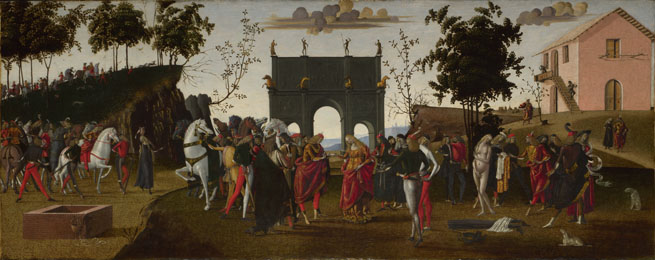
In the three spalliera panels representing Boccaccio’s ‘Story of Griselda’, the compositions are structured around a series of arched buildings projecting social meanings.14 The first panel, ‘Marriage’ (fig. 25), takes place in front of a triumphal arch suggestive of her husband’s wealth, while Griselda’s own rustic origins are established by her father’s house to the right – a clean, respectable, solid house without any adornment.

In the second of the series, ‘Exile’ (fig. 26), the marriage is supposedly dissolved under a freestanding loggia, the type of building referred to in Giovanni Rucellai’s ‘Zibaldone’ as intended for wedding and funeral ceremonies.15 To the right of this panel the wife returns towards her father’s relatively modest house, literally stepping away from the classical elegance of the grand architectural setting into which her husband has brought her. In the final panel, ‘Reunion’, the dining loggia takes centre stage, surrounding and enclosing the figures. Magnificence and formality grow from one panel to the next – a crescendo effect which is largely achieved by the architecture as it increases in scale, moving from the background in ‘Marriage’, to centre-ground in ‘Exile’, to foreground in ‘Reunion’ (fig. 27), but also becoming increasingly splendid, with more and more gilding and relief sculpture.
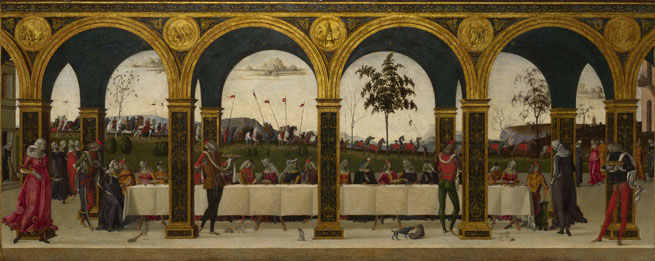
In each case the arches not only frame the narrative and focus attention on particular figures and episodes in the story, but they also underscore the meaning and emotion surrounding Griselda’s changing status. Above all, they perform a celebratory function, so that the rituals and ceremonies associated with marriage are enhanced through their association with elegant ‘all'antica’ architecture, and are strongly and clearly communicated to the viewer.
Read further sections in this essay
- 1. Introduction
- 2. Painted boundaries, thresholds and inner frames
- 4. Open house, open church: architectural dissection
- 5. Interiors: the picture as a room
To cite this essay we suggest using
Amanda Lillie, 'Entering the Picture' published online 2014, in 'Building the Picture: Architecture in Italian Renaissance Painting', The National Gallery, London, http://www.nationalgallery.org.uk/research/research-resources/exhibition-catalogues/building-the-picture/entering-the-picture/apertures-and-arches
